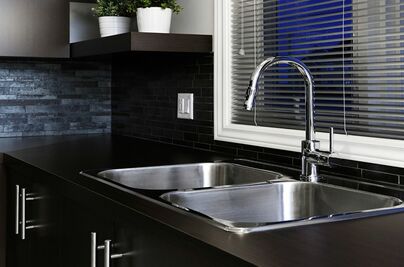Quick And Easy Ways To Installing A Stainless Steel Kitchen Sink
Installing a stainless steel kitchen sink can give your kitchen an instant upgrade in style and function. Whether you’re replacing an existing one or starting from scratch, the process of installing a stainless steel kitchen sink is straightforward, even for beginners. Keep reading to learn quick and easy ways to install your new stainless steel kitchen sink!
They may be used to enhance any kitchen design and have a timeless aesthetic. The durability of stainless steel sinks makes them a wise investment for your house.
Sinks made of stainless steel are not only beautiful, but they are also strong and durable. With some basic upkeep, these types of kitchens are expected to last upwards of 30 years – a testament to its reliability and quality performance.
When you're buying a stainless steel kitchen sink, these are some of the aspects you should keep in mind to make your purchase worth it
Size: Make sure that the sink fits the cabinets and countertops.
Finish: Look for sinks with high-grade finishes, such as brushed or satin stainless steel, to ensure their longevity.
Installation Type: Choose an installation type that works best for your kitchen layout, such as undermount kitchen sink or drop in.
Accessories: Look for additional accessories that can help with the installation and everyday use of your sink, such as strainers and strainers.
Now that you have an idea what to look for when selecting a stainless steel kitchen sink, let’s dive into how to install it in your kitchen.Installing a Stainless Steel Kitchen Sink: A Step-by-Step Guide
1. Start by getting the installation location ready. Make sure you have all the required equipment, such as caulk, pliers, and drill bits.
2. Measure your sink for size and determine the location of where it is going to be installed.
3. Place the sink on a flat surface and use a drill to create holes for the mounting screws.
4. Secure the sink with mounting screws, then attach the gasket to ensure an airtight seal.
5. Connect any necessary plumbing and make sure that everything is securely fastened and water-tight.
6. Lastly, apply caulk around the edge of the sink to ensure a secure fit and waterproof seal.
You have successfully installed your new stainless steel kitchen sink! With these steps in mind, you can easily upgrade or replace your existing kitchen sinks with confidence.
How to select a high-quality stainless steel sink
A form of alloy steel called stainless steel has at least 10.5% chromium and incorporates iron. Because of this, it is more rust and corrosion resistant than other kinds of steel.
Here are some qualities to look for when buying a stainless steel sink:
Stainless Steel's Grade:
Have you ever wondered why the kitchen sink in your neighbourhood is marked 18/8? The stainless steel material's chromium and nickel content are represented by the two numbers in the ratio. So, for a 18/8 label, that means there's 18% chromium and 8% nickel present.The rule of thumb is that the more of these materials stainless steel sinks contain, the higher quality they are.
Another specs to keep an eye out for when opting for a stainless steel sink is the grade. Grade-304 sinks are typically of better quality since they're 18/8 stainless steel and have Iron comprising 50% or more of its make-up.
By knowing about the defining characteristics of stainless steel, you will be able to discern which sinks are better quality and worth your money.
Thickness of the Material:
In addition to the grade of stainless steel, you should also take note of its thickness. Stainless steel sinks may range from 16-22 gauge depending on the quality and type. The lower number indicates a thicker material that is more durable and resistant to dents and scratches.
These sinks are significantly less noisy because they have the ability to absorb noise from running water or garbage disposals.
Insulation and Coatings
In order to reduce noise, sound insulation layers or coatings are frequently applied to stainless steel sinks. Additionally, these coatings prevent condensation buildup on the bottom of the sink- meaning no moisture issues and mold growth under your sink.
Many sinks do not come equipped with insulation or coating, though these features are often available as add-ons when you purchase a sink. That said, it is worth opting for one of these coated or insulated models if you find the sound of stainless steel sinks annoying.
Finish
The "finish" of stainless steel is how the surface looks and feels. A mirror finish means it's polished and smooth, while a matte look makes the surface appear "brushed."
All stainless steel sinks, with the exception of those with a polished mirror finish, will have a grain direction that is noticeable and results from the sink's finishing process. Weather it is black kitchen sink or white kitchen sink, choosing correct finish is important.
How to Maintain Your Stainless Steel Kitchen Sink
Stainless steel sinks are a fantastic option for the kitchen because of their strength and attractiveness. But like any other appliance, they need regular maintenance to keep them looking new. Here are some tips on how to maintain your stainless steel sink.
Clean Regularly
Cleaning your stainless steel sink on a regular basis is one of the most crucial things you can do to maintain its best appearance. To clean the surface, use a soft cloth or sponge and a light liquid detergent.
After cleaning it up, be sure to properly rinse the sink with water and dry it with a soft towel. Abrasive cleaners should also be avoided since they can damage the stainless steel's finish by scratching and dulling it.
Polish the Surface
To keep your sink looking shiny and new, you should also polish it on a regular basis. Use a commercially available stainless steel cleaner/polish to regularly clean, shine and protect the surface of your sink.
Use any cleanser or polish according to the manufacturer's directions, making sure to read them thoroughly. When applying the polish, you could also wish to use a soft cloth or sponge.
Protect from Stains and Discoloration
You should also do your best to protect your sink from staining or discoloration. Avoid allowing foods that are very acidic, such tomato sauce, vinegar, or lemon juice, to sit in the sink for an extended amount of time.
If any of these food items do come into contact with the sink, be sure to rinse it thoroughly with water immediately afterwards. Additionally, avoid leaving dirty dishes in the sink for extended periods of time as well.
Conclusion
If you're considering a stainless steel sink for your kitchen, there are several factors you should take into account such as the grade, thickness, insulation and coatings. By ensuring that your chosen product has all of these features, you can maintain its good looks for many years down the line with only minimal effort. So if you're looking for a durable, long-lasting sink for your kitchen, stainless steel may be the perfect choice.






